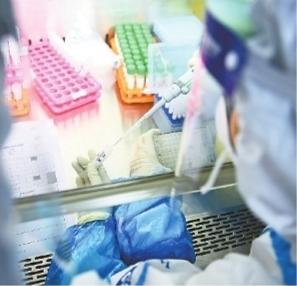The Wuhan "Huoyan" laboratory was launched globally
, and the number of tests per day exceeded 30,000 during the Wuhan epidemic.
The staff passes the nucleic acid test samples through the transfer window to avoid gas intercommunication inside the laboratory. Photo by reporter Jin Zhenqiang
The staff used the sampling tube to take out the sample and put it into the sample plate.
The staff is preparing to test the samples.
On the afternoon of August 3, in the "Huoyan" laboratory of BGI, the laboratory technician Zhang Jiali was adding the swab sample from the sampling tube to the sample plate. In the laboratory, two automated extractors are operating.
In the prevention and control of the new crown pneumonia epidemic in our city, the "Huoyan" laboratory "has a full audience" and participated in multiple key tasks such as resumption of work and production nucleic acid testing, centralized nucleic acid testing and investigation, and the daily test volume can exceed 30,000. , Once the highest in the city.
Today, the "Huoyan" laboratory has "walked" from Wuhan to more than ten cities across the country, and has landed in 17 countries including the UAE, Brunei, and Serbia, and has played an important role in the global fight against the epidemic.
Participated in the "Three Battles" of Wuhan Nucleic Acid Testing
The reporter visited the site, and the "Huoyan" laboratory was built with board room materials and built on the first floor of a building in Optics Valley Biological City. The office area outside the laboratory is simple, but the laboratory has a standard setting, including an inactivation room, a liquid transfer room, a nucleic acid extraction laboratory, and a pathogen amplification room. Inspection technicians wear Level 3 protective clothing and enter the contaminated area through the buffer zone. The sample is transferred through the transfer window to avoid gas intercommunication inside the laboratory.
Zhu Shida, chief commander of BGI's domestic Huoyan laboratory, said that after the samples are sent from the sampling point to the "Huoyan" laboratory, they are first inactivated, then taken out of the sampling tube and placed into the sample plate, and then automated nucleic acid extraction and PCR amplification. If a sample contains the nucleic acid of the new coronavirus, the virus sequence will be detected after 30-40 cycles of amplification.
According to the staff of Wuhan Municipal Health Commission, the "Huoyan" laboratory has participated in the "three major battles" of nucleic acid testing in our city. They are nucleic acid testing for "four types of personnel", nucleic acid testing for resumption of work and production, and the city’s centralized nucleic acid testing. One of the institutions with the strongest testing capabilities has made important contributions to our city's fight against the epidemic.
On August 3, the "Huoyan" laboratory tested 158 samples, but during the concentrated nucleic acid testing in Wuhan, the "Huoyan" laboratory put in 200 inspectors, working "three shifts", and 40 thermal cyclers for 24 hours. Non-stop operation, daily inspection volume exceeds 30,000 copies.
"Self-sufficient" laboratory core equipment and kits
"Huoyan" laboratory, also known as Wuhan Huada's Pathogenic Biosafety Laboratory, reaches P2 safety level. At the end of January and early February, the amount of nucleic acid testing tasks in our city increased sharply. In addition to disease control and medical institutions that can carry out nucleic acid testing, our city actively mobilized third-party testing agencies to participate.
BGI proposed to build a "Fire Eye" laboratory, based on the allusion of "Sun Wukong Fire Eye and Golden Eye", so that the new crown virus "has nowhere to hide". The laboratory covers an area of 2000 square meters and can accommodate enough instruments and personnel. It adopts a negative pressure design. The outside air can come in, but the internal air cannot leak out. It will be discharged through a special filter channel.
“It takes at least 3 months to build such a high-standard negative pressure laboratory based on previous experience, while the China Communications Second Aviation Bureau and us only spent 5 days and 4 nights.” Zhu Shida said.
The small nucleic acid detection kit looks like an ordinary cold kit, but it is unremarkable, but it is a "hunter" for tracking the new coronavirus. Different from other nucleic acid testing laboratories in our city, the core equipment and testing reagents used in "Huoyan" are all independently developed and produced by BGI, and the testing personnel are all self-owned employees. Therefore, the laboratory runs flexibly and closely. efficient.
"Fire Eye" landed in 17 countries around the world
On June 23, Beijing's first gas film version "Huoyan" laboratory was officially put into operation. The laboratory is located in the sports center of Daxing District, Beijing. It is movable and automated. After upgrading, the laboratory has been expanded from 9 air-film cabins to 16, with a daily detection throughput of 100,000, becoming the current global daily detection throughput The largest air film "Fire Eye" laboratory.
Up to now, the "Huoyan" laboratory operated by BGI has been established in 16 major cities including Beijing, Wuhan, Shenzhen, and Tianjin. The national "Huoyan" laboratory has a maximum daily detection throughput of over 200,000 copies.
The "Huoyan" laboratory was born in Wuhan and has gone global. It has become the "Chinese name card" for anti-epidemic actions. It has now landed in 17 countries and regions including the UAE, Brunei, Serbia, Saudi Arabia, Australia, the Philippines, and Canada.
Wang Jian, the founder of BGI, introduced that BGI will be based in Wuhan "Huoyan" laboratory and apply for a national key laboratory to extend the detection technology of "Huoyan" laboratory from infectious diseases to birth defects, tumors and other diseases, creating an industrial cluster . At the same time, in Hanjian Institute of Life Sciences, undertaking basic research in the field of life sciences, helping Wuhan to revitalize.
Reporter Huang Qi, correspondent Gong Bijing

